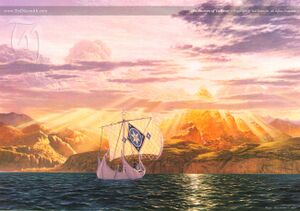Valinor: Difference between revisions
No edit summary |
No edit summary |
||
| Line 24: | Line 24: | ||
| restored = | | restored = | ||
}} | }} | ||
'''Valinor''' ([[Exilic Quenya|EQ]], pron. {{IPA|[ˈvalinor]}}) or '''Valinórë''' (Q, pron. [[Noldorin|N]] {{IPA|[valiˈnoːre]}}, [[Vanyarin|V]] {{IPA|[βaliˈnoːre]}}) is the realm of the [[Valar]] in central [[Aman]]. Aman refers to the whole continent, while Valinor properly refers to the inhabited lands by Valar and the Elves. | '''Valinor''' ([[Exilic Quenya|EQ]], pron. {{IPA|[ˈvalinor]}}) or '''Valinórë''' ([[Quenya|Q]], pron. [[Noldorin|N]] {{IPA|[valiˈnoːre]}}, [[Vanyarin|V]] {{IPA|[βaliˈnoːre]}}) is the realm of the [[Valar]] in central [[Aman]]. Aman refers to the whole continent, while Valinor properly refers to the inhabited lands by Valar and the Elves. | ||
Valinor is the place to which the Valar moved after being driven from [[Almaren]] by [[Melkor]]. | Valinor is the place to which the Valar moved after being driven from [[Almaren]] by [[Melkor]]. | ||
Revision as of 23:20, 19 February 2010
| Valinor | |
|---|---|
 | |
| General information | |
| Location | West of the Pelóri |
| Capital | Valimar |
| People | |
| Language | Valarin, Quenya (including Telerin) |
| Gallery | Images of Valinor |
Valinor (EQ, pron. [ˈvalinor]) or Valinórë (Q, pron. N [valiˈnoːre], V [βaliˈnoːre]) is the realm of the Valar in central Aman. Aman refers to the whole continent, while Valinor properly refers to the inhabited lands by Valar and the Elves.
Valinor is the place to which the Valar moved after being driven from Almaren by Melkor.
Description
Valinor was encircled by the Pelóri mountains, which were raised by the Valar as a defense against Melkor.
Its major city was Valmar, where the Vanyar and the Valar reside. Two other cities are Alqualondë and Tirion, the respective homes of the Teleri and the Noldor. It also has an island, Tol Eressëa, just off its east coast. The sea to the west of the island was called Ekkaia, the encircling sea which surrounded both Valinor and Middle-earth.
Each of the Valar had their own region of the land where they resided and altered things to their desire.
- Yavanna, the Vala of nature, growth, and harvest, resided in the Pastures of Yavanna in the south of the island.
- Oromë, the Vala of the hunt, lived in the Woods of Oromë to the north-east of the pastures. The forest was home to many creatures which Oromë could track and hunt.
- Nienna, the lonely Vala of sorrow and endurance, lived cut off in the far west of the island in the Halls of Nienna where she spent her days crying, looking out to sea. Just south of the Halls of Nienna and to the north of the pastures there were the Halls of Mandos.
- Mandos, the brother of Nienna, was the Vala of the afterlife. All inhabitants of Arda went to the Halls of Mandos should they happen to die, mortals and immortals alike although it was said that in death as in life, they were separated. Also living in the Halls of Mandos was his spouse Vairë the weaver, who wove the threads of time.
- To the east of the Halls of Mandos was the Isle of Estë, which was situated in the middle of the lake of Lórellin
- To the south were situated the Gardens of Lórien also known as Irmo, the Vala of dreams. Estë and Lórien being husband and wife lived close together.
- To the north of this were the Mansions of Aulë the smith Vala who was spouse to Yavanna.
- In the north-east lay the Mansions of Manwë and Varda, the two most powerful Valar.
To the west of them stood the mound Ezellohar with the Two Trees of Valinor, Telperion and Laurelin.
After the destruction of Númenor, the Undying Lands were removed from Arda so that Men could not reach them and only the Elves could go there by the Straight Road and in ships capable of passing out of the Spheres of the earth. By special permission of the Valar, the Hobbits Frodo Baggins, Bilbo Baggins were permitted to go to Valinor. They were followed by Samwise Gamgee and Gimli the Dwarf who were perhaps also permitted.
Etymology
Valinor (archaic Valinórë) is Quenya meaning "Land of Valar". There is also the name Valandor of roughly the same meaning.
The terms Ever-eve or Evereven also referred to Valinor. In Hobbit lore, the mythical West was known as Faery.
Inspiration
It has been suggested that the concept is mainly based on the legend of Faery of western mythology, as indicated by the hobbitish name.
Furthermore, it seems to have been based on ghost and heavenly islands of ancient and medieval legends: Avalon, Hy Brasil, the Blessed Isles, the Elysian Fields, were mythical lands envisioned by the ancient peoples to be far into the western ocean. The legend somehow survived the Middle-Ages with Saint Brendan's Island
| Ainur | ||
|---|---|---|
| Valar | Lords | Manwë · Ulmo · Aulë · Oromë · Mandos · Irmo · Tulkas · |
| Valier | Varda · Yavanna · Nienna · Estë · Vairë · Vána · Nessa | |
| Maiar | Arien · Blue Wizards · Eönwë · Gandalf · Ilmarë · Melian · Ossë · Radagast · Salmar · Saruman · Tilion · Uinen | |
| Úmaiar | Sauron · Balrogs (Gothmog · Durin's Bane) · Boldogs | |
| Concepts and locations | Almaren · Aratar (indicated in italics) · Creation of the Ainur · Fana · Máhanaxar · Ainulindalë · Order of Wizards (indicated in bold) · Second Music of the Ainur · Timeless Halls · Valarin · Valinor · Valimar | |
